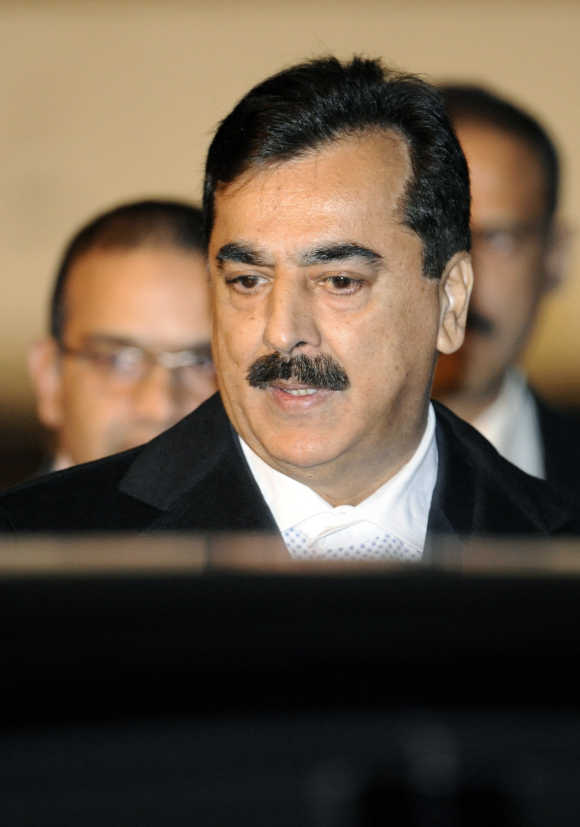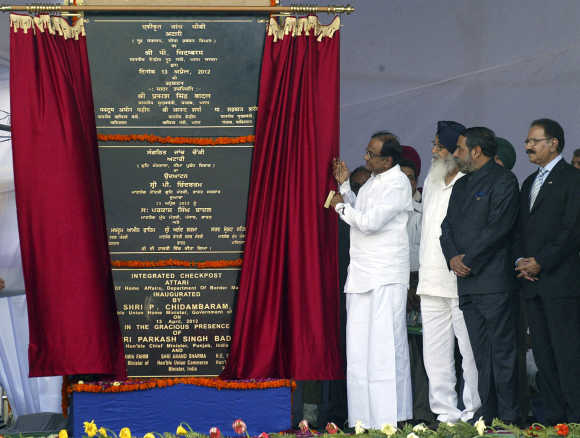 | « Back to article | Print this article |
One year on, India-Pakistan trade ties leapfrog
On April 28, 2011, both sides had issued an ambitious joint statement that vowed to improve trade ties between the neighbours, a move that had raised several eyebrows.
The statement was issued after the fifth round of commercial and economic cooperation talks between India's Commerce Secretary Rahul Khullar and his Pakistani counterpart, Zafar Mahmood, in Islamabad.
The talks were spearheaded by Commerce & Industry and Textiles Minister Anand Sharma and Pakistan Commerce Minister Makhdoom Amin Fahim, though the foundation was laid by Prime Minister Manmohan Singh and his counterpart, Yousuf Raza Gilani.
The discussions had heralded a new future in bilateral economic relations.
Click NEXT to read more...
One year on, India-Pakistan trade ties leapfrog
The statement had proposed some far-reaching and ambitious targets, which at that time seemed impossible to achieve, given the history of the two nuclear-armed neighbours.
The proposals were strengthened by the successive visits of Fahim and Mahmood to India and Sharma's visit to Pakistan earlier this year.
One of the primary proposals in the joint statement was Pakistan granting a trade status of most-favoured nation to India to increase trade between the two.
In November 2011, Pakistan's Cabinet gave an in-principle approval for 'trade normalisation' with India, and said the MFN status would be granted gradually.
Click NEXT to read more...
One year on, India-Pakistan trade ties leapfrog
It was understood that when the MFN status would be granted, all items, excluding those in the South Asian Free Trade Agreement sensitive list, would get preferential access at the peak tariff level of five per cent by the end of 2012.
In March, Pakistan did away with the positive list with India completely, and introduced a negative list. So far, Pakistan had maintained a so-called 'positive list' for trading with India. This list accounted for 1,963 items it could import from India.
However, now, it opened its markets to a much wider range of Indian goods, though it introduced a negative list of 1,209 items it couldn't import from India.
Click NEXT to read more...
One year on, India-Pakistan trade ties leapfrog
As a result, India can now export more than 7,500 tariff lines to Pakistan. The move was hailed by business communities from both sides.
Though it was initially planned that Pakistan would introduce the negative list by October 2011, the process was delayed, as India was not able to remove some non-tariff barriers it had promised, to increase the flow of Pakistani goods into Indian markets.
Also, the Pakistan business community was apprehensive of domestic industry being hit by the flooding of Indian goods in that country.
Another significant proposal in the joint statement was the relaxation of the visa rules for businessmen.
The joint working group set up for this purpose had finalised a proposal that would reduce the paperwork required to secure visas and do away with the mandatory police reporting for those visiting India for business purposes.
Click NEXT to read more...
One year on, India-Pakistan trade ties leapfrog
The Ministry of Home Affairs has now approved a policy with two broad categories of criteria, based on which a Pakistani businessman can secure a single entry or multiple entries in a year.
The home secretaries of both countries would meet by the end of next month, after which the new visa rules would be notified.
The long-drawn proposal of opening bank branches in each other's territory has also made considerable progress. Officials from both central banks, the Reserve Bank of India and the State Bank of Pakistan, had recently met and finalised a deal to open banking outlets in each other's country, a move that would reduce transaction costs for exporters.
Click NEXT to read more...
One year on, India-Pakistan trade ties leapfrog
Approvals of India's Department of Economic Affairs and the Department of Industrial Policy and Promotion and Pakistan's finance ministry are awaited.
An integrated checkpost at the Wagah-Attari border was scheduled to be made operational by October 2011 to boost trade through the land route.
However, it was opened earlier this month. As a result, trading hours would now be increased and infrastructure for large container vehicles would be set up. The checkpost at the border was opened days after Pakistan President Asif Ali Zardari visited India and held extensive discussions with Prime Minister Manmohan Singh.
External Affairs Minister S M Krishna said both leaders discussed significant changes in economic relations.
Click NEXT to read more...
One year on, India-Pakistan trade ties leapfrog
He added Prime Minister Singh had told Zardari to take strong action against terrorism to ensure a smooth bilateral relationship.
In another significant step, India would soon allow foreign direct investment from Pakistan by amending the Foreign Exchange Management Act. Though the government has already given its in-principle nod to the proposal, the formalities are still being worked.
The ministries of home, defence and finance, which had earlier expressed reservations on the move, are now on board and it is expected the Reserve Bank of India would notify the rules soon. Both countries have also agreed to try and increase bilateral trade from the current $2.7 billion a year to $6 billion by 2013-14.







